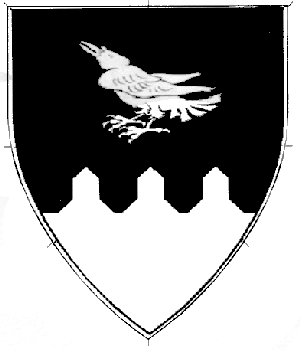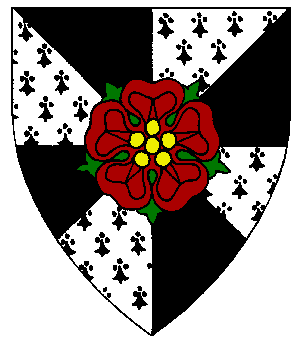1. Æsa Hrólfsdóttir
New name and device submission.
Azure, a sun in splendour and on a chief Or two ravens respectant azure.
The submitter seeks a feminine name authentic for the Norse
language/culture. She will allow minor changes, and in the event of
such changes cares most about language/culture.
Æsa can be found in Geirr-Bassi as a feminine given
name. Hrólfr can be found in the same work as a
masculine given name. The formation of the patronymic follows the
pattern set out in Geirr-Bassi.

2. Annabelle Perrot
New name and device submission.
Gules, two lions rampant addorsed tails entwined Or langued and clawed azure and on a chief dancetty Or, five annuli azure.
The submitter requests an authentic English/French/Scottish feminine
name from between 1450 and 1550. She wants the name to be authentic
for both language and time period and will allow only minor changes.
This name was originally submitted in April 2006 and pended by Crux
for lack of documentation for the given name Annabelle.
Crux has contacted the submitter and discussed this matter and decided
to proceed with the submission noting the perferred documentable form
Anabelle which appears in the early 1400s as
documented in Saint Gabriel report #1011 in the LoI.
Under the header spelling Ananbel(la), Withycombe
lists several variants of the name, including Annabel, Anabel,
Anabill, Anabul, Annable and Annaple.
Annabella is said to be the Latinized version of
the name. No variant of the name with the desired spelling
Annabelle is cited.
Variants of Annabel can also be found in Reaney and
Wilson, as evidenced by Talan Gwyneks article
"Feminine Given Names in 'A Dictionary of English Surnames'"
[http://www.s-gabriel.org/names/talan/reaney/reaney.cgi?Annabel,
accessed 18/01/2006]. Cited variants of the name include
Anabel, Anabella, Anabille etc. Again there is no evidence
for the desired spelling. We note however previous registration of
the desired spelling, so have not changed the submitted name in the
hope that the College may find the required evidence. If the name
must be changed from the requested spelling then the submitter
would prefer Anabelle as an alternative. This
alternative is one of the spellings cited in Saint Gabriel report
#1011 [http://www.s-gabriel.org/1011, accessed 24/05/06].
Perrot is found in "Given Names from Brittany,
1384-1600" by Tangwystyl verch Morgant Glasvryn dated to 1444 [
http://www.s-gabriel.org/names/tangwystyl/latebreton/, accessed 22nd
April 2006.] It is also found in Black which lists
Perrot s.n. Parratt, Parrott, Perratt, Perret as a
common French variant of the name.

3. Ava del Mas
Device resubmission.
Purpure, a chalice Or and on a bordure argent an orle of ivy vert.
This device was originally returned by Crux in January 2006 as it was
felt to not be representative of period heraldry. The depiction of the
vine was thought to be inconsistent with period heraldic practice and
we could not find a single instance of such a motif in period
heraldry. After discussing the submission with Ava in person at
Festival, Crux feels that this version is acceptable and has sent it
on to the CoA for consideration.
The submitter's name was registered on the November 2005 LoAR.

4. Avery of the Wode
Quarterly azure and argent, in bend sinister two winged serpent embowed, counterembowed sable.
Name and device Resubmission.
The submitter's original name "Avery the Seeker" was returned in
March 2006 by Crux for lack of documentation of the element
"the Seeker". This version is completely different and so
has none of the previous problems. Originally submitted as
"Avery of the Wood" it was pended in April 2006 as Crux wished
to alter the spelling of "Wood" to the period form "Wode" to met the
submitters request for authenticity (see below).
The submitter's original device "Gyronny sable and vet a dragon's
eye Or" was return in March 2006 by Crux as it violated RfS
VIII.2.b(iv)and the primary charge is no longer registerable in the
SCA. This version is completely different and so has none of the
previous problems. The second version of this device "Quarterly
azure and argent, in bend sinister a winged serpent and a winged
serpent contourny embowed, counterembowed sable" was pended by Crux
with the name in April 2006 and the submitter was asked to consider
the more period style of having the charges faced the same way. The
submitter agreed with Crux's suggestion and the device was altered
to its current form.
The submitter requests an authentic 13th century English masculine
name and will allow only minor changes.
Avery is found in Saint Gabriel Report # 838 as an
English given name dated to 1273
[www.panix.com/~gabriel/public-bin/showfinal.cgi/838.txt,
accessed 27th of January 2006].
We find several 13th centuries versions of locative bynames s.n.
Wood all spelt as Wode in Reaney and
Wilson; de la Wode dated to 1242,
del Wode dated to 1274, Atewode
dated to 1274, the Wode and a la
Wode dated to 1275, in la Wode dated to 1279,
of the Wode dated to 1285 and at the
Wode dated to 1293. All of the above examples are locative
bynames relating to residence in or near a wood, however there are other
13th century citations for the name from it's alternate meaning;
le Wode which occurs in 1221, Wod which
is found in 1230 and le Wod dated to 1275. The alternate
meaning for wode is "frenzied or wild" hence Shakespeare's
"And here am I, and wood within the wood" from A Midsummer Night's
Dream.
The earliest use of Wood in a name element we could
document was from the mid 1500s. We are thus changing the spelling of
the locative byname to "Wode" to met his request for authenticity.
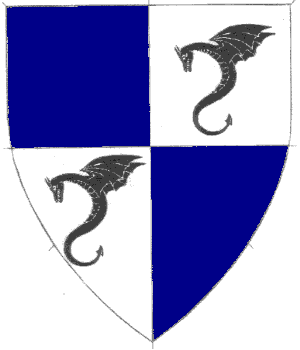
5. Ayla Bogenschütze
Argent, on a chevron between two bows in chevron strung to base and a quiver with three arrows purpure, four horse shoes inverted argent.
Name and Device Resubmission.
The submitter requests an authentic 15th century German feminine
name meaning "Ayla the horse archer". This name was originally submitted
as "Alya die Pferd Bogenschütze" which was pended
by Crux in March 2006 as it was improperly constructed and as the
submitter would only allow only minor changes we could not correct
it. She has since agreed that we can drop the elements "die Pferd".
Ayla is found in "15th Century German Women's names"
by Talan Gwynek [ www.s-gabriel.org/docs/german15f.html, accessed
23rd of January 2006]. It is also found as a Frankish given name
in the Saint Gabriel Report # 706
[www.panix.com/~gabriel/public-bin/showfinal.cgi/706.txt,
accessed 31st of January 2006].
We can document Bogenschütz as a 15th Century German
surname. We find dated example for men with the surname
Bogenschtz in 1435 and 1499 in "Etymologisches
Woerterbuch der deutschen Familiennamen" by Brechenmacher on page 172
under the header spelling Bogenschtz.
The submitter's original device "Argent, on a chevron between a
bow fesswise strung to base and a quiver with three arrows purpure,
four horse shoes inverted argent" was return in March 2006 by
Crux for a redraw as the chevron was too low. Were delighted that
the submitter took our suggestions for a reblazon and included
two bows instead which gives a much better balanced device when she
resubmitted the device in April 2006. Unfortunately we were forced
to pend it at that time due to problems with her name. Now that those
issues are resolved the device may be sent to Laurel.
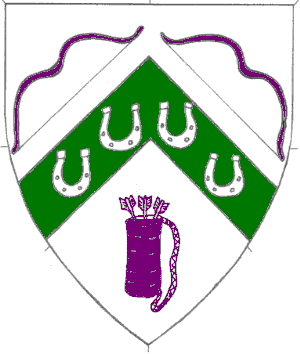
6. Bertram of Saint Monica
New name submission (see Returns for device).
The submitter seeks a male name and makes no request for authenticity.
He will accept any changes.
Talan Gwynek's "Medieval German Given Names from Silesia"
[http://www.sca.org/heraldry/laurel/names/bahlow_v.htm,
accessed 25/01/2006] cites an instance of Bertram as
having occurred in 1387.
Saint Monica is an SCA group whose name was registered
in June of 1989 via the West Kingdom.
7. Catalina de Gata
Vert, on a bend sinister argent three lions heads erased gules.
Device Resubmission.
This submitter has a long history of resubmissions with the Crux office.
The submitter's original device "Gules, on a bend Or three lions'
heads palewise gules" was return by Crux in October 2001 for
conflict with Sebastian de Ventbarré "Gules, on a bend sinister Or,
three wings palewise, each terminating in a hand brandishing a sword
sable". In November 2005 the submitter resubmitted the device
and provided an email from Sebastian of Ventbarré stating he was happy
to allow permission to conflict. However, as emails do not contain a
signature they are not an acceptable medium for what is a legal
document waving the right of unique arms in the SCA. While Sebastian
seemed quite happy to give the permission he never supplied a signed
document to that effect. Crux pended the submission to try to get a
signed document. In the meantime Catalina has decided to change
device by selecting a different field, bend tincture and orientation.
The submitters name was registered on the March 2002 LoAR.
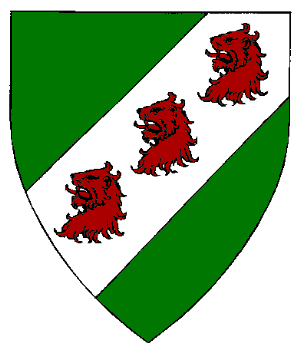
8. David de Derlington
Gules, on a fess between three leopard's faces Or three cross crosslets gules.
New name and device submission.
The submitter seeks a masculine name and makes no request for
authenticity. He will allow minor changes and in the event of such
changes cares most about sound.
David appears as a header spelling in Withycombe.
The name is said to have originated as Hebrew and used in Wales and
Scotland as early as 601 and 1084 respectively. It first appears in
England in the 12th century.
de Derlington is cited s.n. Darlington
in Reaney and Wilson as having occurred in 1258-9. (Note that it
doesn't appear in the 2nd edition of this work.)

9. Draco de Euruic
Gules, a triskelion of dragon's heads and on a bordure argent an orle sable.
New name and device submission.
The submitter seeks a male name and makes no request for
authenticity. He will allow minor changes, and in the event of such
changes cares most about meaning and sound.
Draco is said to be cited in Morlet s.n. Drag-.
We don't have access to this work, so can't check the citation but will
send it forward to the CoA for verification.
Euruic appears in Ekwall s.n. York.
This is cited as the variant of York that appeared in the Domesday
Book.

10. Eirikr the Eager
Change of holding name.
The submitter's original name Eirikr Þorolfsson was returned by
Laurel on the January 2005 LoAR for aural conflict, at this time
the holding name "Eirikr of Ynys Fawr" was created.
The submitter request a name, he doesn't make any requests for
authenticity and will allow any changes.
Eirikr (Eir{i'}kr) is listed on page 9 of Geirr
Bassi Haraldsson's "The Old Norse Name", there having been 12
instances of the name in the Landn?mab?k from which Geirr Bassi was
partially drawn. Eirikr (Eir{i'}kr) also occurs as a header spelling
in Lind's "Norsk-Isl?ndska Dopnamn ock Fingerade Namn fr?n
Medeltiden". The name seems to have been extremely common; citations
from 951 and 1000 show the desired spelling.
Eager appears in the Oxford English Dictionary, with
several different meanings in period. The following is an account of
the different period spellings and meanings of the word:
Meaning pungent and associated with disease:
egre 1374 (Chaucer)& 1544
eigre 1575
ægre 1601
eager 1601 (Shakespeare) Meaning of words biting or sharp:
egre 1386 (Chaucer)
eager 1593 (Shakespeare) Meaning sour of taste:
egyr 1350
egre 1460-1470
eager 1575
aygre 1602 (Shakespeare) Meaning of a cutting tool biting or sharp:
eager 1611 Meaning imperfectly tempered metal:
eager 1580 Meaning of beasts of prey fierce:
egre 1386 (Chaucer)
egar 1530
eager 1580 Meaning hungry as applied to falcons (see previous entry):
eegre 1486
eagre 1575 Meaning of people or creatures strenuous, argent, fierce or angry:
egre 1297, 1380 & 1475
egor 1400
egyr 1485
eigre 1555
ægre 1610 Meaning of people keen:
eger 1400 & 1596
eigre 1501
eager 1647 We note that eager also had a meaning in period of people to be annoying or irritating which is now obsolete having died out in the 1580s, it seems to have been a more common meaning of the word as applied to people than the modern "keen". Thus, someone in period called "the Eager" is likely to have this meaning or the fierce or angry connotation associated with them. We imagine such a person would readily pick bar fights!
Of the meanings cited above which apply to people we have the desired spelling of eager from 1647 which is just before the SCA compatibility cut off of 1650. A more period form would be the common spelling eger, however the desired spelling is allowed.
We note also that the combination of Norse and English in a name is a weirdness. We can document bynames meaning "keen" in norse and thus should be able to use the lingua anglica allowance to support this submission.
11. Eleyne de Comnocke
Blanket letter of permission to conflict with name.
The submitter has included a letter that conforms to the standard
letter given in appendix D of the Administrative Handbook. She
additionally notes that he grants permission for registration of
names identical to her registered name (should that ever become
possible).
12. Eleyne de Comnocke
Blanket letter of permission to conflict with device.
The submitter has included a letter that grants permission for
submitter's to register devices at least one countable difference
away from her registered device "Purpure, a saltire and on a chief
argent, three roses purpure barbed vert and seeded Or". The letter
conforms to the standard letter given in appendix D of the
Administrative Handbook. The submitter's device was registered on
the October 2004 LoAR.
13. Eleyne de Comnocke
Release of device.
Per saltire argent and purpure, in pale two roses and in fess two wolves salient counterchanged.
This device was registered in April 1996 via Caid. The submitter
registered another device in October 2004 via Lochac: "Purpure, a
saltire and on a chief argent, three roses purpure barbed vert and
seeded Or". By the forms, the earlier device was supposed to be
released upon registration of the later device, but the LoI did not
state that and Laurel did not release the earlier device. This
action corrects the situation.
14. Eleyne de Comnocke
Addition of joint owner owner Kaspar von Helmenstede for badge.
(Fieldless) A mascle quarterly purpure and Or.
This badge was registered in August of 2004. The submission stated
that it was to be jointly owned by Kaspar von Helmenstede (name also
registered August 2004), but this was fact was omitted from the LoI
and was not noted by Laurel. This action corrects the situation.
15. Hagen von Dürnstein
Argent, a fox rampant within an orle gules.
New name and device submission.
The submitter seeks a name of unspecified gender, makes no request for
authenticity but will accept any changes.
This name was originally pended in April 2006 by Crux for lack of
documentation for the element Dürnstein.
Hagen is found in Socin, on page 567, with 13th
century citations for Hagen von Lorrach and Hagen Sigrist.
Dürnstein is the modern name for a town on the banks
of the Danube in Austria. It was here that Richard the Lionheart was
held in captivity. We could find no period evidence for the modern
spelling of the name. A 1650 map of Bohemia viewable from
http://alabamamaps.ua.edu/historicalmaps/europe/centraleurope.html
includes the town with the spelling Tyrnstain. Further
the municipal website of the town states that the original name of the
city was Tyrnstein. We could find no other period
places called Dürnstein. (The submitter, who is
Austrian made calls to Austria which verified that
Tyrnstain was indeed the originally spelling of the
town).
The submitter will accept this alternate spelling
Tyrnstain if the college is unable to find evidence
for the submitted form.
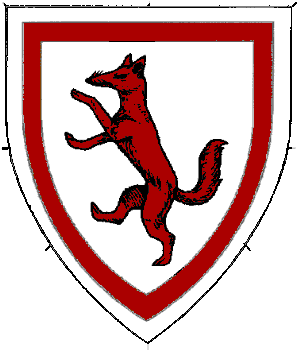
16. John Bucstan de Glonn
Per chevron azure and gules, a fleur-de-lys and an orle Or.
Device Resubmission.
This submitter originally submitted the device "Per fess indented
azure and gules, in chief two fleur-de-lys Or" to Crux in May 2005
and then subsequently requested it to be withdrawn from consideration
by the College of Arms, as recorded on Lochac's July LoI.
He then submitted a version of this design which was returned by Crux
in September 2005 as the line of division was
incorrectly located. This version corrects the previous problem.
The submitters name was registered on the September 2005 LoAR.
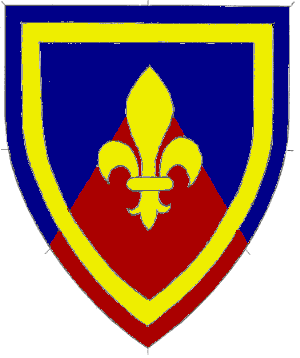
17. Katherine Kerr of the Hermitage
Per fess and per pale embattled argent and sable, in bend two boarhound's heads couped close and in bend sinister two towers palewise all counterchanged.
Name and Device Resubmission (Appeal).
The submitter seeks a feminine name authentic for 16th century
Scotland. She will allow minor changes and in the event of such
changes cares most about sound.
Three instances of Katherine are cited in Talan Gwynek's
"A List of Feminine Personal Names Found in Scottish Records Part
Three: Post-1400 Names"
[http://www.s-gabriel.org/names/talan/scottishfem/scottishfemlate.html,
accessed 25th May 2006]. The three citations are from 1512, 1542 and
1564.
Kerr appears in Black on pg 394, where it is dated
to 1357.
of the Hermitage is a locative byname referring to
the Hermitage fortress. Period references to the castle's name are
reproduced in Steel "He was carried to his castle of Hermitage in a
condition such as to make his recovery uncertain" and Bingham
"…that I wish Stirling of Jedburgh, Glasgow to be the Hermitage, and
I the Earl of Bothwell as I lie here, …".
This device was previously returned in kingdom because the boarhounds
were not considered identifiable. The submitter has provided an image
of a Garter stall plate said to be original dating from circa 1483/4
(she has provided a letter from the Assistant Archivist of St.
George's chapel on the matter). This crest on this stall plate is
provided as documentation of the depiction of the boarhound.
Unfortunately, we don't believe that the crest looks much like the
submitted boarhounds, particularly in the muzzle area, which we
believe is an important distinguishing feature of a hound.
The original submission of this name and device was pended by Crux in
March 2004 for lack of documentation for the name. It was reconsidered
at the April 2004 meeting and returned by the interim Crux for
"lack of supporting documentation; probable conflict with famous
mundane author Katharine Kerr; and being of incompatible with period
content".
The previous return for name conflict with the author Katharine Kerr
is erroneous as the addition of the element "of the Hermitage" clears
the conflict. We are not sure what "lack of supporting documentation"
or "being of incompatible with period content" refers to but suspect
it is for the construction of the name using "of the Hermitage" which
is not clear from the previous information. The device was returned as
the boarhounds's heads were not identifiable and not considered to be
depicted in a period style.
The submitter is appealing the previous Crux return and so the
submission will now be sent straight to Laurel. We agree that the previous
return was not an accurate reflection of the rules and did not clearly
indicate under which rule the submission was being returned. There is
sufficient documentation for the name construction and the submitter
has argued that the boarhound's heads are of a period style as evidenced
by the crest on the Garter stall plate shown below.
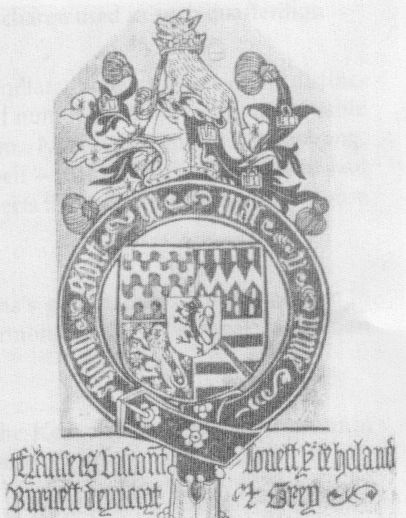
While the majority of people present at the meeting felt that the
depiction of the boarhounds's heads on the device did not match that
shown on the Garter stall plate and that they were still unidentifiable,
as an appeal it must be sent to Laurel regardless.

18. Magdalena da Colle Santa Lucia
Argent, an hourglass azure within a bordure potent vert.
Name and Device Resubmission.
This name and device were originally returned by Crux in May 2005.
The name was returned because although the submitter provided several
extracts from an Italian book as evidence for the place
Colle Santa Lucia, she did not include copies of the
title page. This device was returned for a redraw as the bordure was
not drawn correctly. This submission corrects all of these problems.
The submitter seeks a feminine name authentic for Italy. She will
allow minor changes and in the event of such changes cares most about
meaning.
Magdalena is cited as a 14th/15th century Florentine
name can be found in Rhian Lyth of Blackmoor Vale's "Italian
Renaissance Women's Names"
[http://www.s-gabriel.org/names/rhian/italian.htmlm accessed 15 March
2005].
Colle Santa Lucia is a small town in Northern Italy.
The submitter has provided a number of citations from an Italian
language book, Pallabazzer and Chizzali. The book contains numerous
references to the Church of Santa Lucia, after which the town is said
to be named, but it is not clear whether the form of the name was as
submitted in early times. A representative translated quote is
"First mention of the Church of St. Lucia goes back to 1336…".
Thankfully, the book contains a German document dated 1300-1600 which
refers to the town. "Ess hat in diser herrschaft ein stadliches
grosses perkwerk von eisen und stachel bei dem dorf Col Sa. Lucia…"
- In this dominion there are iron mines, quite considerable, situated
near the village of Colle St. Lucia.

19. Rosamond de Montford
.
New name submission (see Returns for device).
The submitter seeks a feminine name and makes no request for
authenticity. She will accept any changes and cares most about sound
if such changes prove necessary.
Rosamond occurs as a header spelling in Withycombe.
The name is said to derive from Old German Rosamunda
and was introduced into England by the Normans. Rosamond is dated to
1282.
Montford appears as a header in Reaney and Wilson.
Several variants of the name are cited, including Montfort, (1086),
Munford (1082) and Muntford (1200) as well as the desired spelling in
1086.
20. Tatiana Konstantiniya Ruslanova
Purpure, three serpents embowed and interlaced within a bordure nebuly argent.
New Name and Device submission.
The submitter seeks a feminine name authentic for the Russian
language/culture. She will allow minor changes and cares most about
sound in the event of such changes.
Tatiana appears in Saint Gabriel report #113
[http://www.s-gabriel.org/113, accessed 19/07/2005]. The name is said
to derive from a 3rd century Greek martyr and was adopted into
Russian. It is first found in Russian in 1356.
Tatiana also occurs in the Tatiana Nikolaevna
Tumanova's "The Complete Russian Name Book", where it is said to
derive from Tatius, a Sabine king.
Konstantiniya also appears in the same work as a
feminine form of Konstantin. The submitter omitted
the final "I" from this name element. We have added it to match the
documentation, though we are unsure whether the submitted form could
be a plausible variation.
Ruslanovna appears s.n. Ruslan as a
patronymic form. The submitter omitted the final "n" from this name
element. Paul Goldschmidt's "Paul Goldschmidt's Dictionary of Russian
Names - Grammar" [http://www.sca.org/heraldry/paul/zgrammar.html,
accessed 25th May 2006], seems to indicate that
Ruslanova is a sensible feminine patronymic.

